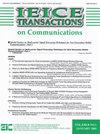流量减少技术和数据聚合控制,以最大限度地减少物联网系统的延迟
IF 0.6
4区 计算机科学
Q4 ENGINEERING, ELECTRICAL & ELECTRONIC
引用次数: 2
摘要
物联网(IoT)的普及导致了大量数据的产生,需要大量的通信、计算和存储资源。云计算在实现大多数物联网应用中发挥着重要作用,这些应用被分类为垂直领域的海量机器类型通信和网络物理控制应用。为了处理越来越多的物联网数据,通过将计算和存储资源分配到网络边缘端来减少集中在云中的流量,并抑制物联网应用的延迟是很重要的。在本文中,我们首先介绍了最近关于雾/边缘计算和数据聚合的文献综述,作为有效利用物联网系统中通信、计算和存储资源的代表性流量减少技术,然后重点关注数据聚合控制,以最大限度地减少物联网网关中的延迟。然后,我们提出了统计和非统计数据聚合的统一建模,并分析了其延迟。解析推导了延时平稳分布的Laplace-Stieltjes变换和平均,并近似求出了平均延时;随后,我们将其应用于时变数据到达的自适应聚合数控制。通过使用时变泊松输入和非泊松输入(如Beta输入)进行仿真,明确了典型的物联网流量模型的瞬时流量特性,即吸收流量波动,实现稳定的最优延迟。关键词:物联网、雾、边缘、数据聚合、QoS、延迟、控制、通信质量、通信流量本文章由计算机程序翻译,如有差异,请以英文原文为准。
Traffic reduction technologies and data aggregation control to minimize latency in IoT systems
The spread of the Internet of Things (IoT) has led to the generation of large amounts of data, requiring massive communication, computing, and storage resources. Cloud computing plays an important role in realizing most IoT applications classified as massive machine type communication and cyber-physical control applications in vertical domains. To handle the increasing amount of IoT data, it is important to reduce the traffic concentrated in the cloud by distributing the computing and storage resources to the network edge side and to suppress the latency of the IoT applications. In this paper, we first present a recent literature review on fog/edge computing and data aggregation as representative traffic reduction technologies for efficiently utilizing communication, computing, and storage resources in IoT systems, and then focus on data aggregation control minimizing the latency in an IoT gateway. We then present a unified modeling for statistical and nonstatistical data aggregation and analyze its latency. We analytically derive the Laplace–Stieltjes transform and average of the stationary distribution of the latency and approximate the average latency; we subsequently apply it to an adaptive aggregation number control for the time-variant data arrival. The transient traffic characteristics, that is, the absorption of traffic fluctuations realizing a stable optimal latency, were clarified through a simulation with a time-variant Poisson input and nonPoisson inputs, such as a Beta input, which is a typical IoT traffic model. key words: IoT, fog, edge, data aggregation, QoS, latency, control, communication quality, communication traffic
求助全文
通过发布文献求助,成功后即可免费获取论文全文。
去求助
来源期刊

IEICE Transactions on Communications
工程技术-电信学
CiteScore
1.40
自引率
28.60%
发文量
101
审稿时长
3.7 months
期刊介绍:
The IEICE Transactions on Communications is an all-electronic journal published occasionally by the Institute of Electronics, Information and Communication Engineers (IEICE) and edited by the Communications Society in IEICE. The IEICE Transactions on Communications publishes original, peer-reviewed papers that embrace the entire field of communications, including:
- Fundamental Theories for Communications
- Energy in Electronics Communications
- Transmission Systems and Transmission Equipment for Communications
- Optical Fiber for Communications
- Fiber-Optic Transmission for Communications
- Network System
- Network
- Internet
- Network Management/Operation
- Antennas and Propagation
- Electromagnetic Compatibility (EMC)
- Wireless Communication Technologies
- Terrestrial Wireless Communication/Broadcasting Technologies
- Satellite Communications
- Sensing
- Navigation, Guidance and Control Systems
- Space Utilization Systems for Communications
- Multimedia Systems for Communication
 求助内容:
求助内容: 应助结果提醒方式:
应助结果提醒方式:


